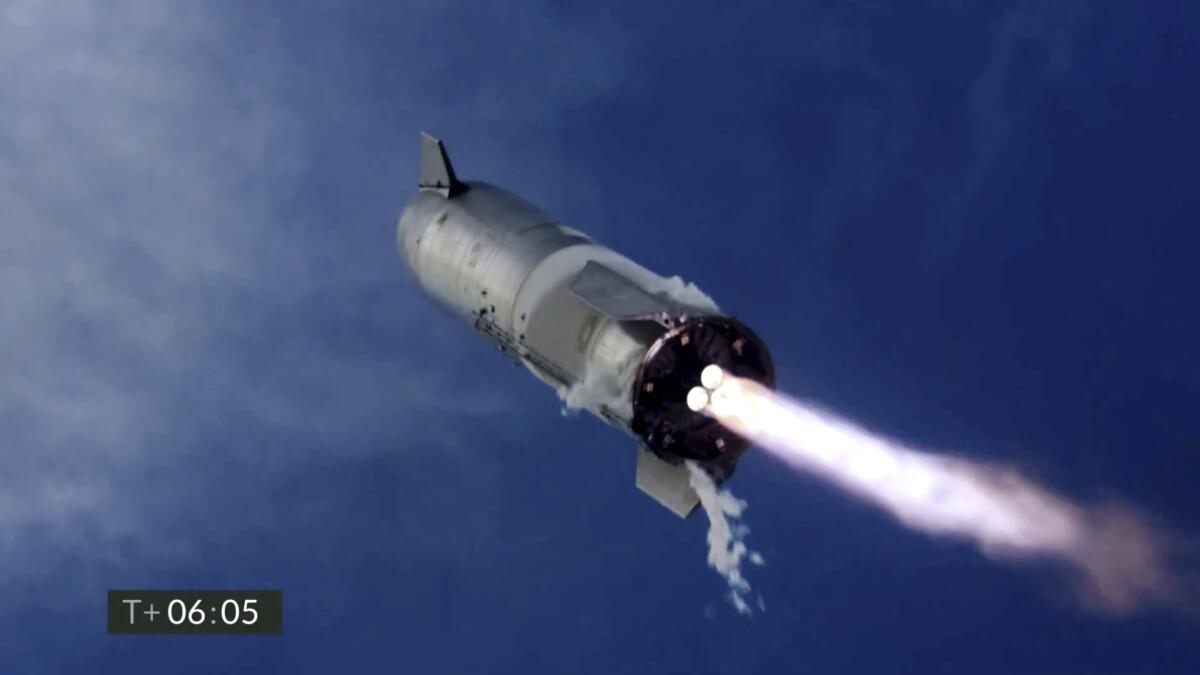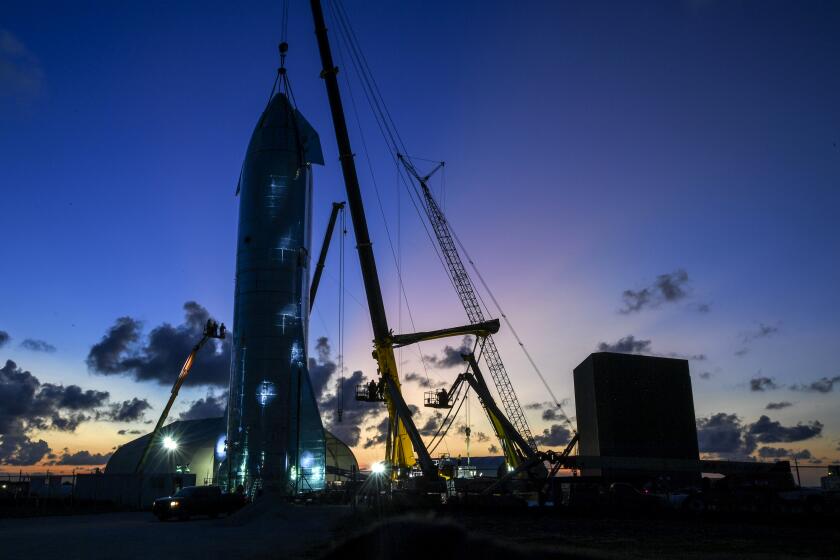NASA picks SpaceX to create system to land astronauts on the moon

- Share via
Elon Musk’s SpaceX won a NASA contract to develop a system for landing astronauts on the moon, beating out fellow billionaire Jeff Bezos’ Blue Origin and a unit of Leidos Holdings Inc.
NASA awarded the lander contract Friday after 10 months of development work. The plan by SpaceX — which is based in Hawthorne and whose full name is Space Exploration Technologies Corp. — depends on refining its Starship vehicle and Super Heavy rocket, which are also in development, as a fully integrated lunar landing system, Musk said last year.
The Starship craft is nearing its fifth test; the previous four suffered mishaps including fires and an explosion.
The company is building and testing its Starship spacecraft in Boca Chica Village, Texas. Musk has said he wants to create a city called Starbase, which would encompass the village and surrounding area, and has put out a call on Twitter for engineers, technicians and other workers to move to the area.
The proposed city of Starbase, Texas, would fit into a long tradition of communities dominated by a single employer
The lunar-lander contract deepens SpaceX’s increasingly crucial relationship with NASA, which already uses the company’s Falcon 9 rockets and Dragon capsules to ferry astronauts and cargo to the International Space Station. SpaceX plans to launch its third crew of NASA astronauts to the space station as soon as next week.
The lunar lander is a key aspect of NASA’s Artemis program to return astronauts to the moon for the first time since the Apollo missions.
The total value of the contract is $2.89 billion, NASA said Friday. As part of the contract, SpaceX will need to complete a crewed demonstration mission — sending people to the moon to prove the system works. Operational missions will be a separate contract.
“This critical step puts humanity on a path to sustainable lunar exploration and keeps our eyes on missions farther into the solar system, including Mars,” Kathy Lueders, NASA’s associate administrator for the Human Explorations and Operations Mission Directorate, said in a statement.
The Washington Post, owned by Bezos, first reported the news of the contract win.
The Blue Origin team also included Lockheed Martin Corp., Northrop Grumman Corp. and Draper, an engineering and avionics firm. Dynetics, a unit of Leidos, was the other company that had won a preliminary contract to develop a lander.
Bezos first unveiled a mock-up of the team’s lunar cargo lander, known as Blue Moon, in 2019. At the time, he said his company had been working on the lander since 2016.
NASA budgeted $967 million for work by the three teams over 10 months, starting in May 2020. The Trump administration tasked NASA with returning astronauts to the moon’s South Pole in 2024. Given NASA’s current funding levels, 2024 is widely seen as a difficult target for an astronaut landing; President Biden could revise that schedule.
On Friday, Steve Jurczyk, NASA’s acting administrator, appeared to soften on that goal, saying there’s “maybe a shot” SpaceX could perform its landing test in 2024.
Starship is just one of the spacecraft that could be part of the U.S.’ return to the moon. The four-astronaut crew is set to launch aboard NASA’s massive Space Launch System rocket — which is being made by Boeing Co. and has yet to fly — and will ride to lunar orbit in the Lockheed Martin-built Orion capsule, NASA said Friday.
The Los Angeles Air Force Base’s Space and Missile Systems Center in El Segundo will become the headquarters of the Space Force’s Space Systems Command.
Two of the crew members will then transfer from the capsule to SpaceX’s human lander for the journey to the lunar surface. Those astronauts will stay on the moon for a week before ascending in the lander and returning to the Orion capsule, then coming back to Earth, NASA said.
NASA will also continue development work on a lunar gateway that orbits the moon, an astronaut way station to and from the moon’s surface.
Case and Bachman write for Bloomberg. Masunaga is a Times staff writer.
More to Read
Inside the business of entertainment
The Wide Shot brings you news, analysis and insights on everything from streaming wars to production — and what it all means for the future.
You may occasionally receive promotional content from the Los Angeles Times.













